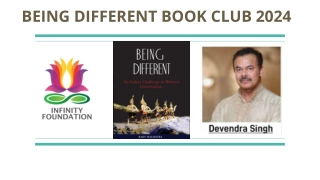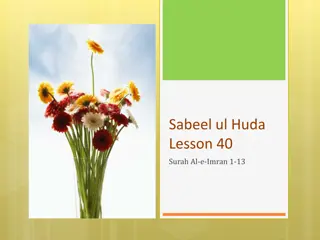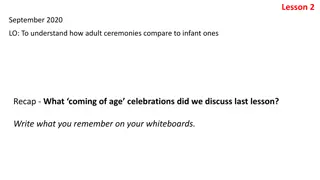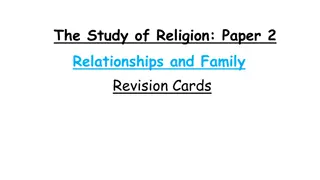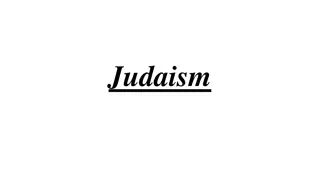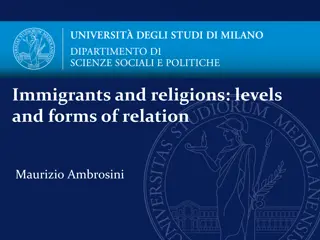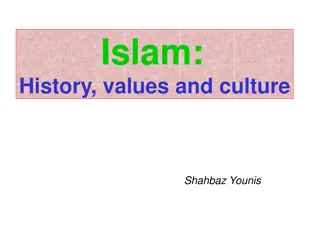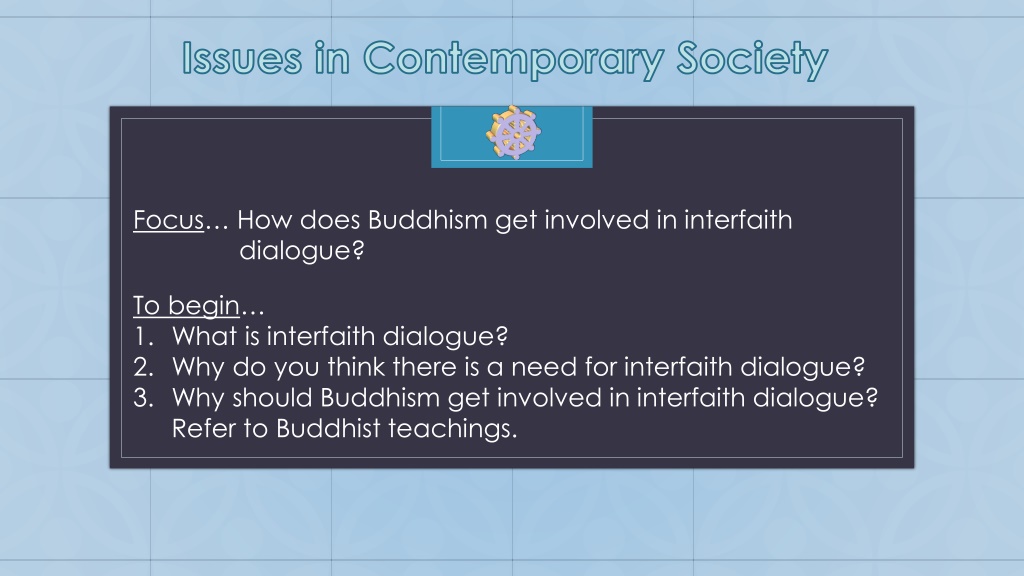
Buddhism and Interfaith Dialogue: Importance and Engagement
Explore the involvement of Buddhism in interfaith dialogue, emphasizing the necessity for mutual understanding, respect for other religions, and eradication of prejudices based on Buddhist teachings and historical examples. Discover the significance of interfaith relations for Buddhists in multicultural societies and the potential barriers in engaging in dialogue with different traditions.
Download Presentation

Please find below an Image/Link to download the presentation.
The content on the website is provided AS IS for your information and personal use only. It may not be sold, licensed, or shared on other websites without obtaining consent from the author. Download presentation by click this link. If you encounter any issues during the download, it is possible that the publisher has removed the file from their server.
E N D
Presentation Transcript
Issues in Contemporary Society Focus How does Buddhism get involved in interfaith dialogue? C To begin 1. What is interfaith dialogue? 2. Why do you think there is a need for interfaith dialogue? 3. Why should Buddhism get involved in interfaith dialogue? Refer to Buddhist teachings.
Issues in Contemporary Society a) The significance of teachings that underpin involvement and support in and for liberationist approaches to religion and society, religious freedom, religious tolerance, pluralism and interfaith dialogue for Buddhists in a multicultural society. b) The ways that Buddhists respond to diversity in different traditions of Buddhism. How different Buddhist traditions view other religious and non- religious world views and their truth claims. c) The benefits, extent of the involvement and potential barriers from a Buddhist context, including the difference in application and importance of interfaith dialogue in light of different traditions of Buddhism, including the different cultural and country contexts in which Buddhists are found. With reference to the ideas of the 14th Dalai Lama and K Sri Dhammananda.
Issues in Contemporary Society Read and answer 1. Why is mutual understanding and cooperation between religions important? 2. How did Buddha set the precedent for respecting other religions? 3. Why. Give some examples from Buddhist teaching and history that show Buddhism should have no prejudices. 4. Use a quotation to explain the main purpose of the Bhikkhus in Buddha s time. What was not the purpose? 5. What did Buddha say Buddhism was not? What did he encourage people to do regarding religious truths?
Issues in Contemporary Society Read and answer 6. How did Emperor Ashoka influence beliefs about non-violence and other religions? Include a quotation in your answer. 7. What does the author say about religions and violence? 8. Give reasons for why the author suggests there is a need for the religions of today to get together . 9. What does the author suggest religions should not be confined to ? What should religion be doing? 10. What should different religions beliefs not be used for? 11. Explain why interfaith dialogue is possible (as suggested by the author).
Issues in Contemporary Society Read and answer 12. Explain what Buddha says divides men among themselves. What happens when this is overcome? 13. What does the author say religions should eradicate and introduce? For what purpose? 14. Give examples if religious teachings (including a Buddhist one)that suggests some religious values are very similar. What affect might this have on interfaith dialogue? 15. Explain reasons why interfaith relations/dialogue may be problematic. Give examples where Buddhist beliefs may differ and make dialogue difficult. Refer to specific beliefs and attitudes to specific issues.


